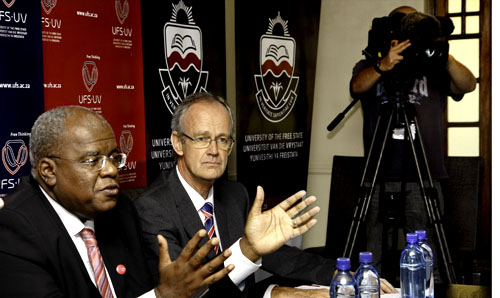 |
Prof. Jonathan Jansen, Vice-Chancellor and Rector, and Prof. Teuns Verschoor, Vice-Rector of Institutional Affairs, during the media conference to launch the new brand.
- Photo: Hannes Pieterse |
A new chapter was written in the history of the University of the Free State (UFS) on Thursday, 27 January 2011 when it launched its revitalised brand image.
The brand evolution has resulted in the adoption of two primary brands to engage with its stakeholders – an evolved academic crest and a new marketing brand for the institution’s offerings and services.
The university, which recently won the World Universities’ Forum award for academic excellence and institutional transformation, was founded in 1904 as a dynamic learning environment where academic excellence and the development of leadership qualities are long-standing traditions. These values are the backbone of the university and the foundation of the new brand as it seeks to adapt to the changing needs of society, without sacrificing its rich history and heritage.
The process of revitalising and creating a renewed image of the UFS, spearheaded by the university’s inspirational leader, Prof. Jonathan Jansen, started in February 2010 and involved a comprehensive and consultative process to understand the deep insights that underpin the fabric of the institution among its key stakeholders.
“We engaged in one of the most expansive and intensive process of consultations with staff, alumni, senate, council and other stakeholders to determine how and in what ways our brand could signal a more inclusive and forward-looking vision that captured the spirit and essence of the new country and a transforming university,” says Prof. Jansen.
The new brand is anchored in the university’s renewed motto “In Veritate Sapientiae Lux” (In Truth is the Light of Wisdom), which has been evolved to embrace the diversity of the community the university without losing its essence. As Judge Ian van der Merwe, Chairperson of the UFS Councilnoted, “the motto retains concepts with which not only Christians can identify, but which also accommodate all the different viewpoints of the UFS’s diverse students and staff. Hereby a feeling of unity and belonging is promoted.”
The new brand identity was developed by the country’s foremost academic branding authority, the Brand Leadership Group. “We worked with the university to develop a brand that reflects an inclusive, forward-thinking truly South African university in tune with its changing environment which embraces its past, present and signals the future,” says Thebe Ikalafeng, founder of Brand Leadership Group.
The new brand has found resonance with the various university stakeholders. “The end product is excellent,” commented Mr Naudé de Klerk, Chairperson of Kovsie Alumni. “It represents a history of hope, excellence, innovation and transformation. Above all, it represents a leap of faith, which extends from a humble beginning in 1904 to the strong and vital academic institution it is today.”
Finally, where it matters, the new brand also gets the students’ vote. “Our new brand illustrates and communicates to the rest of the world the message that we as the University of the Free State refuse to be tied down to the failures of the past, but instead confidently sprint forward to the successes of tomorrow,” says Modieyi Motholo, Chairperson of the university’s Interim Student Committee.
Media Release
27 January 2011
Issued by: Lacea Loader
Director: Strategic Communication (actg)
Tel: 051 401 2584
Cell: 083 645 2454
E-mail:
news@ufs.ac.za